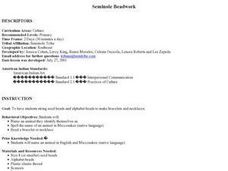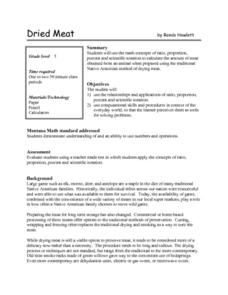Curated OER
African American Homesteaders
Students analyze the reasons African-Americans settled in the area to be known as Nebraska. Using primary source documents, they read about the challenges they faced and compare their growth and distribution of African-Americas in the...
Curated OER
Seminole Beadwork
Students name an animal they identify with, spell the name of an animal in Miccosukee (a Native American language), and make beaded bracelets or necklaces from seed and alphabet beads.
Channel Islands Film
Lone Woman of San Nicolas Island: Lesson Plan 2
After watching West of the West's documentary The Lone Woman of San Nicolas Island, class members imagine how Juana Maria/Karana may have felt about living alone on the island for 18 years and craft a blackout poem or a narrative in her...
Curated OER
Dried Meat
Learners investigate the traditional method of drying meat used by Native Americans. They apply math concepts such as ratio, proportion, percent, and scientific notation to determine the amount of meat the is dried from an animal using...
Curated OER
MAPPING THE BLACK ATLANTIC
Students examine the geographic characteristics of Western and Central Africa, the impact of geography on settlement patterns, cultural traits, and trade. They compare political, social, economic, and religious systems of...
Curated OER
Breathing New Life into Old Traditions
Learners investigate the role of ceremonies and other traditions of Native American cultures. They research various Native American nations and create posters that visually depict their research.
Curated OER
Inference By Analogy
Students infer the use or meaning of items recovered from a North Carolina Native American site based on 17th-century European settlers' accounts and illustration.
Curated OER
Family Life in America: Past, Present and Future
Ninth graders brainstorm the economic and social functions of a family. In groups, they research the roles of each member of a family in the past and compare it with their family today. In groups, they develop criteria for what the...
Curated OER
Legends as Oral History
Sixth graders read First Nations legends to find information about the First Nations. In this legends as oral history lesson, 6th graders interview and write oral histories from family members.
Curated OER
Civilizations of the Americas
Study and compare multiple aspects of both Aztec and Inca civilizations. Young historians explain how each of the empires came to be, and how they were both defeated by the Spanish. The resource starts out as a good lesson, but is...
Curated OER
Exploring Folk Traditions and Folk Beliefs
Ninth graders work together to brainstorm an idea to focus on the similiarties and differences between various cultures. Individually, they interview family members using questions they created based on their topic. They use their...
Curated OER
Where the Red Fern Grows: A 4th Grade Literary Focus Unit
Fourth graders explore the human and animal connection along with the idea that death is a part of the life cycle. They read "Where the Red Fern Grows." Students examine the feelings and emotions surrounding death and they discover the...
Curated OER
Weaving Traditions - Activity 1
Students practice the techniques of weaving and braiding in this introductory lesson on family traditions and visual art. The lesson includes a video and other resource links.
Curated OER
Life on Plymouth Plantation
Third graders research life of Plymouth Plantation and write letters about life there home. In this Plymouth life lesson plan, 3rd graders complete a webquest as they gather information about the journey to America on the Mayflower and...
Curated OER
No Choice!
Students investigate freedom. In this character development and U.S. history lesson, students participate in role playing in which the teacher assigns recess restrictions including whom they play with and what they play. Students discuss...
Curated OER
History & Diversity
Students list the qualities needed to build strong family relationships. They gain an appreciation for the sacrifices of their ancestors who came to America and gain insights into the many fine qualities of minority families.
Curated OER
We the People (Cultural Research)
Fourth graders conduct cultural research, collect oral histories using tape recorders and cameras, and share their ancestral heritage with classmates through family heirlooms and ethnic foods.
Curated OER
Women in Rural India
Tenth graders view women's lives in a north Indian village around 1970 with pictures.
Curated OER
Communication on the Frontier: Postcards from the Edge
Eleventh graders explore the innovative ways pioneers used to leave messages along the trail to communicate to family and friends who were to follow.
National Park Service
Leave it to Beavers
Many people know cats mark their territories by rubbing the back of their necks to leave a scent, but not many people know beavers also leave a scent to mark their territories. During the first activity of two, scholars use their noses...
Smithsonian Institution
Dia de los Muertos: Celebrating and Remembering
Help scholars understand the history, geography, traditions, and art of Dia de los Muertos, the Day of the Dead. Find background information for your reference as well as a detailed cross-curricular lesson plan. Learners compare...
Curated OER
Learning from the Past: A New Approach
Young scholars research nonprofit organizations. As they research, they learn how those living in the colonial period formed community organizations to provide for the common good of their society. Each pupil chooses one organization to...
Curated OER
Migrating to Texas
Fourth graders explore the migration to Texas from other parts of the United States. Through journal entries they write about the trip as if they were the settlers coming to a new and foreign country. Working in small groups, 4th graders...
Curated OER
Brutal British
Students read and predict the outcome of a story set during the Civil War, then map the story. To prepare for the activity, students determine why it is important to look at historical events from all angles by using primary and...

























